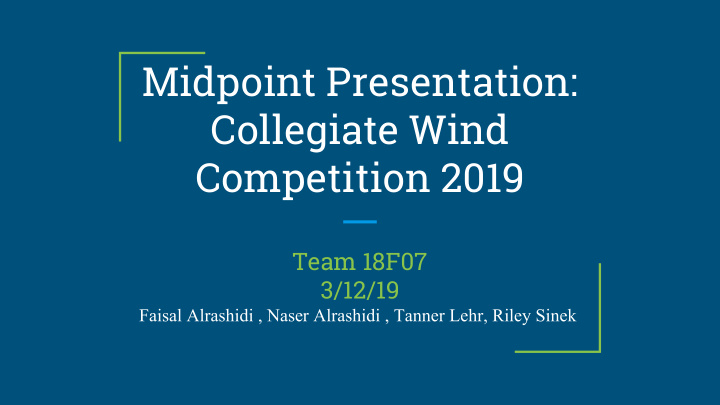



Midpoint Presentation: Collegiate Wind Competition 2019 Team 18F07 3/12/19 Faisal Alrashidi , Naser Alrashidi , Tanner Lehr, Riley Sinek
Product Description ● U.S. Department of Energy is the sponsor ● Collegiate Wind Competition ○ Competition held in Boulder, Co. May 6th-9th . ○ Fifth team representing NAU at the Competition. ○ Collaboration with Electrical Engineers. Naser 1
Proposed Design CAD model of our proposed design. ● Figure 1: CAD model Naser 2
Current State of Manufacturing Completed In Progress ● Yaw ● Brake Rotor Brake Calipers/Bearing Block ● ● Shaft Nacelle (holes need to be drilled) ● Blades/Pitching Mechanism ● ● Base Plate Tower ● Naser 3
Blades Update FEA showed us that the blade material ● properties will be sufficient ○ Factor of Safety: 3.468 The team’s generators have high cogging ● torques-require high rotor solidity Figure 2: Blade FEA Riley 4
Hub Update The hub was redesigned for the ● new pitching mechanism layout ● Modifications to the swashplate will be necessary Figure 3: Front view of rotor Figure 4: Swashplate mechanism Riley 5
Hub Safety FEA was run on the hub ● ○ Identified stress concentrations Showed locations of failure ○ Figure 5: Initial Hub FEA ● The hub was modified to have higher thickness and larger radii in corners The claws were found to not fail under ● loading circumstances Figure 6: Iterated Hub FEA Riley 6
Generator Testing Rectifier needed to be built for ● the DC load ● Dyno testing to evaluate motor characteristics Gimbal motor shorted during first ● test Figure 8: Generator Testing Figure 7: Dynamometer Riley 7
MAD 5010 motor results Linear Relationship with Power ● ● Output power remains below the motor power output Turbine will have access to all of the ○ generator’s potential power Figure 9: MAD motor results Riley 8
Tail - Yaw Update We showed you last update ● - We wanted to use aluminum but it would be too hard to manufacture - Because of this we changed Figure 10: Initial Tail design our design Faisal 9
Tail - Yaw Update ● We made it bigger ( We need to maximise surface area ) ● Split it two pieces with a logo NAU ( It was too big to make in one piece ) ● We 3D printed with abs plastic ( It’s less heavy than aluminum and easier to manufacture ) Figure 11: Final Tail Design Faisal 10
Shaft Update Shaft for last semester ● ● Material Used for testing Carbon steel, alloy steel, Stainless steel The length 125mm and diameter ⅜ in Design torque = 3.8877N.m ● ● Bending moment = 0.4905N.m Figure 12: Previous Shaft Design ● Three lengths were used L=10 cm , L=15 cm and L=20 cm Naser 11
Shaft Update We use two flat surfaces instead of keyway ● ○ Based on the individual analysis we decided that will be best. The material is 1018 steel . ● Figure 13: Current Shaft Design Naser 12
Brakes Update Last Update ● Linear Actuator on paper could apply the most pressure for braking ○ Testing needed to be done Figure 14: Initial brake design Tanner 13
Brakes Update Current Update ● Testing Required force estimated with wind speed, mass of braking system, and time to stop ○ ○ Each device was tested 10 times and averaged Linear actuator proved to be the best design ● Table 1: Brake Strength Comparison Tanner 14
Brakes Update Brake Design Iteration ● Designed a couple iterations that work for linear actuators Figure 15: Previous Brake Design Figure 16: Final Brake Design Tanner 15
Tower, Base Plate, and Yaw Bearing Update Last Update Tower Base Plate Yaw Bearing ● Tower was ● Had no changes ● No design was made tapered and not from design given last semester easy to by the DOE manufacture Current Update Tower Base Plate Yaw Bearing ● 1018 Steel ● Added slots for ● Added two bearings to Figure 17: Current Tower Design ● Finalized at 17” connecting during allow the turbine to tall, OD 1.5” competition turn into the wind Tanner 16
Nacelle Update Last Update ● There was only two levels to the nacelle Current Update ● Made 3 levels to accommodate for storing electrical components Figure 18: Nacelle Design Tanner 17
Testing the Design The team will use a local wind tunnel to test the design ● ● The objectives of tunnel testing will be: ○ Ensuring proper operation ○ Validating safety ○ Charging a battery similar to competition standards Riley 18
Table 2: Gantt Chart Schedule The schedule need to update. We will build a wind turbine on 3/29/219 . Faisal 19
Budget Table 3: Current Budget Sheet This is the stuff we ● bought ● We do not plan on purchasing anything els at the moment Faisal 20
Future Work ● Communicate with DOE about which contests the team will participate in ● Presentation and Report due to the DOE Poster for presentation due upon arrival ● Faisal 21
Questions?
Recommend
More recommend